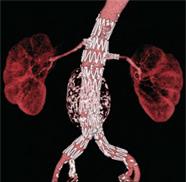Atrium Health Navicent Heart & Vascular Care
Endovascular Abdominal Aortic Aneurysm Repair (EVAR)

What Is an Endovascular Abdominal Aortic Aneurysm?
An abdominal aortic aneurysm is the bulging or misshaping of the abdominal aorta, most often caused by atherosclerosis. Other causes are possible as well, including trauma, cystic medial necrosis, syphilis, and genetically inherited connective tissue disorders.
Abdominal aortic aneurysms are most common in white males over the age of 65. Tobacco smoking is one of the biggest factors affecting abdominal aortic aneurysms, and unfortunately, the mortality rate is extremely high.
The detection of abdominal aortic aneurysm is difficult because they are asymptomatic. Patients who are diagnosed with an abdominal aortic aneurysm tend to find out after a routine x-ray.
After being diagnosed with an abdominal aortic aneurysm, most patients choose between open-heart surgery or endovascular abdominal aortic aneurysm repair, also referred to as EVAR. EVAR is generally considered the safer, more advanced option.
What Is Endovascular Abdominal Aortic Aneurysm Repair?
Endovascular abdominal aortic aneurysm repair is a surgical procedure that involves inserting a graft into an aneurysm through an entrance made with small groin incisions. X-rays help to visualize the system of arteries and guide the graft into place.
EVAR is considered safer than open-heart surgery because the abdomen does not need to be opened. The small incisions in the groin heal much more quickly than the large incisions that would have been necessary for the abdomen. Patients who choose EVAR spend less time in the hospital in recovery.
With endovascular abdominal aortic aneurysm repair, patients need to undergo another operation at a later time to adjust the original procedure.
What Are the Complications Related to Endovascular Abdominal Aortic Aneurysm Repair?
Certain patients are not suitable candidates for EVAR. Aneurysms that occur close to the kidney are difficult to treat with EVAR and are considered on a case-by-case basis. A physician generally scans first to determine whether the aneurysm can even be treated by endovascular repair.
Although endovascular abdominal aortic aneurysm repair is far safer than open surgery, the procedure still comes with its own set of risks. The graft attachment necessary for EVAR to be successful sometimes slips and follow-up scans are necessary to ensure that it is secure. Roughly, 1 in 10 patients requires a secondary procedure to shift the graft back into the right place.
Complications that arise with any medical procedure apply to EVAR as well, including infection or diarrhea. Further risks include heart attack, stroke, kidney failure, loss of circulation, or infection in the graft. Approximately 10% of men find it difficult to maintain an erection after the surgery due to injury to the nerves in front of the aorta.
What Is the Recovery Time After EVAR Like?
Patients who undergo endovascular repair usually stay in the hospital ward for one to three days. Eating or drinking should not be impeded by the procedure, but patients should wait until they are completely awake from sedation. Nurses will be around to support, guide the patient, and help with sitting up and walking. Once a patient is able to get around on his or her own, he or she will be allowed to leave the hospital and return home. Painkillers may be prescribed for approximately one week depending on the individual patient.
Most patients who have undergone endovascular repair are back to full health in about two weeks. Older patients or those with compromised health may take longer and take up to several months to return to the state they were in prior to the operation. It is important to gradually increase the amount of activity throughout the recovery process. Most patients are able to return to work within a month of the surgery.
What Do I Do After Getting Endovascular Abdominal Aortic Aneurysm Repair?
Although EVAR helps to alleviate one symptom of atherosclerosis, it is still preventable by lifestyle. Without major changes to diet, activity, and overall lifestyle, it is difficult to maintain a healthy circulatory system, even after surgery.
The number one cause of an abdominal aortic aneurysm is smoking, so the first thing patients should do after getting EVAR is quit. Quitting smoking will help to protect not just the aorta, but also all the arteries in the body, dramatically decreasing the risk of heart disease, heart attacks, and strokes. All physicians are trained to help with smoking cessation, and many support groups exist to help former smokers.
General physical activity like walking or cycling is recommended once a complete recovery has been made after endovascular abdominal aortic aneurysm repair. Exercise maintains a healthy balance of cholesterol in the body and helps to control body weight, two major factors in causing abdominal aortic aneurysms.
Patients who undergo EVAR are generally at high risk for heart disease and heart attacks. It is imperative that they maintain a healthy blood pressure. Blood pressure for high-risk patients should be checked regularly, at least once every six months. Medication that is prescribed for high blood pressure should be taken as dosed by your physician.
Diabetes is another major factor in causing an abdominal aortic aneurysm. Blood sugar levels should be monitored and maintained as prescribed by your physician.
High blood cholesterol, leading to atherosclerosis is the number one cause of abdominal aortic aneurysm. Because of this, it is important to eat a healthy, balanced diet and to maintain a healthy weight. Cholesterol levels should be tested regularly, and any medications prescribed to control cholesterol should be taken as prescribed. Exercise will also work to control the levels of healthy and unhealthy cholesterol.